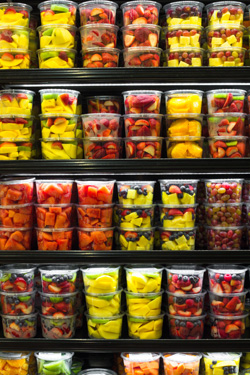 The first step involves analyzing the amount of food leftover each day or week. Collecting data on the amount and types of food items remaining will help you manage inventory and determine food waste. For excess packaged items, it may be possible to adjust delivery quantities or schedule.
The first step involves analyzing the amount of food leftover each day or week. Collecting data on the amount and types of food items remaining will help you manage inventory and determine food waste. For excess packaged items, it may be possible to adjust delivery quantities or schedule.
If items can be donated every few days, the next step is to partner with a food rescue organization (see No. 2). The items and quantities being donated don’t need to be consistent week to week, and the organization will ensure each donation makes its way to those in need. Even a few boxes of donated product are enough for an agency to make the trip to pick it up.
There are many organizations accept and distribute donated food. Feeding America, for example, is a nationwide network of food banks in the United States that facilitates connections to local entities in need that also accept convenience store products.
For retailers with stores in multiple regions and states, Feeding America can formalize a process across local food banks. For smaller companies and single-store operators, Feeding America operates MealConnect. When donors post food to donate on MealConnect online or through the program’s mobile app, an algorithm determines the best suited agency to distribute the donation. The affiliated Feeding America member food bank is instantly notified and supervises the donation process. MealConnect will track donation activity and provide year-end tax receipts as well as quantities of donations (in pounds and meals served).
Most categories of food can be donated. When donating fresh and prepared food, the products must be protected the same as food for sale to prevent food contamination. Store product at the proper temperature, in sealed packages, covered containers, or wrapped as well as labeled with allergen warnings and date labels. The Bill Emerson Good Samaritan Food Donation Act encourages food donations by providing liability protections for businesses that donate ”apparently wholesome” food in ”good faith” to nonprofit organizations.
Some food banks have restrictions on food donations. Most will not accept fresh items past the package label, but some canned, boxed and bottled items may have an extended shelf life. Check with the pantry or bank to validate their policy. Going forward, make note of items nearing their expiration date and plan to donate in advance.
For fresh items, work with your food production lead or supplier/distributor to determine a process for determining date limits.
 A food donation program should also establish well-documented procedures that protect the safety of donated foods.
A food donation program should also establish well-documented procedures that protect the safety of donated foods.
For prepared foods, temperature logs show proper temperature has been maintained. Determine processes for cooling hot foods safely and in the correct time frame. You may need to consider packaging that is wrapped or airtight as well as create labels that include date and allergens for items that are not normally packaged.
Employee education is also important to ensure everyone can easily follow each aspect of the program. When introducing a food donation program, hold staff meetings and create easy to follow checklists. Share the process with partner organizations so everyone involved is on the same page. Establish a feedback loop between store staff and the partner organization to make improvements as necessary.
Tip: Purchase or order branded totes in large quantities to use for donation collection and pickup. Decide if the store or the agency is responsible for cleaning the totes after each pickup or delivery.